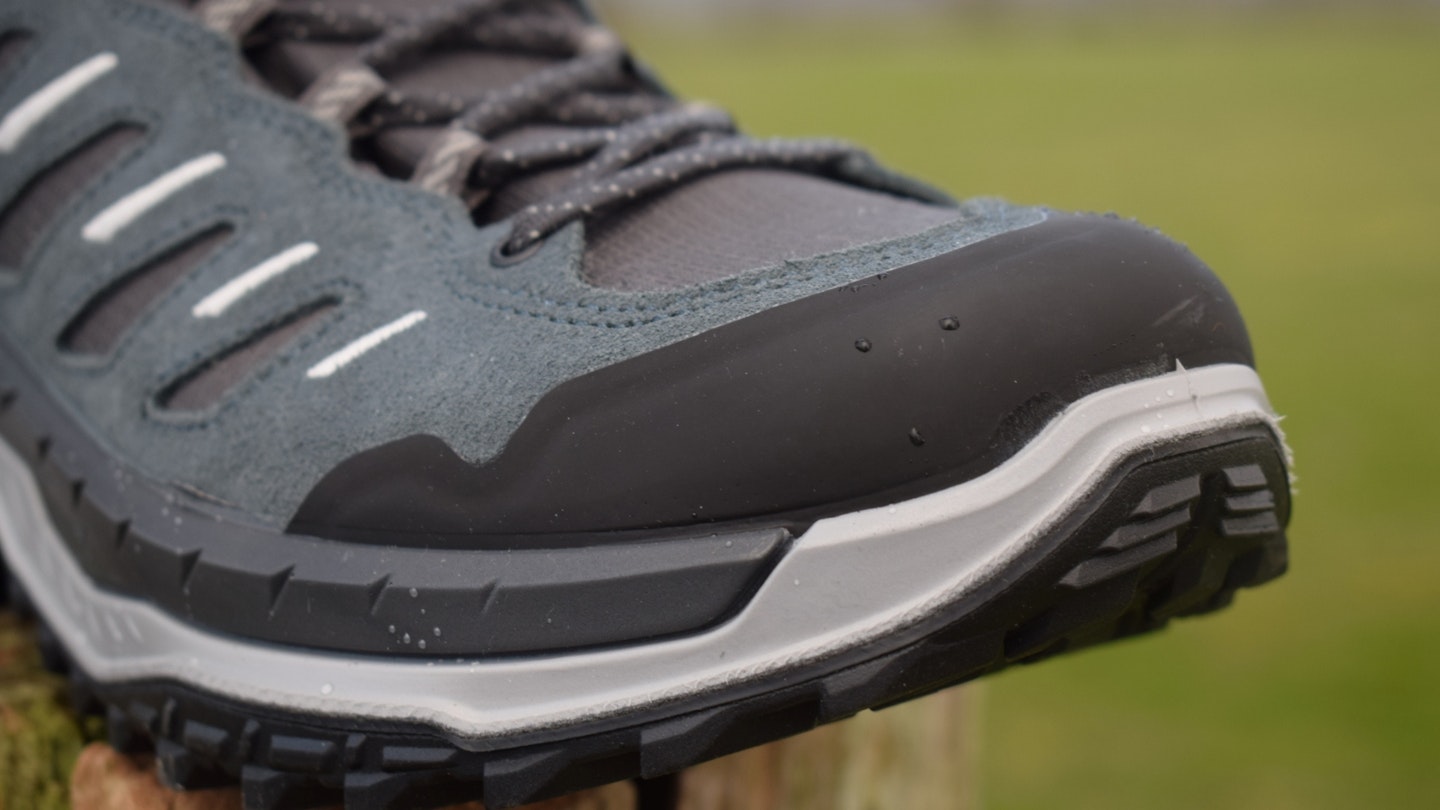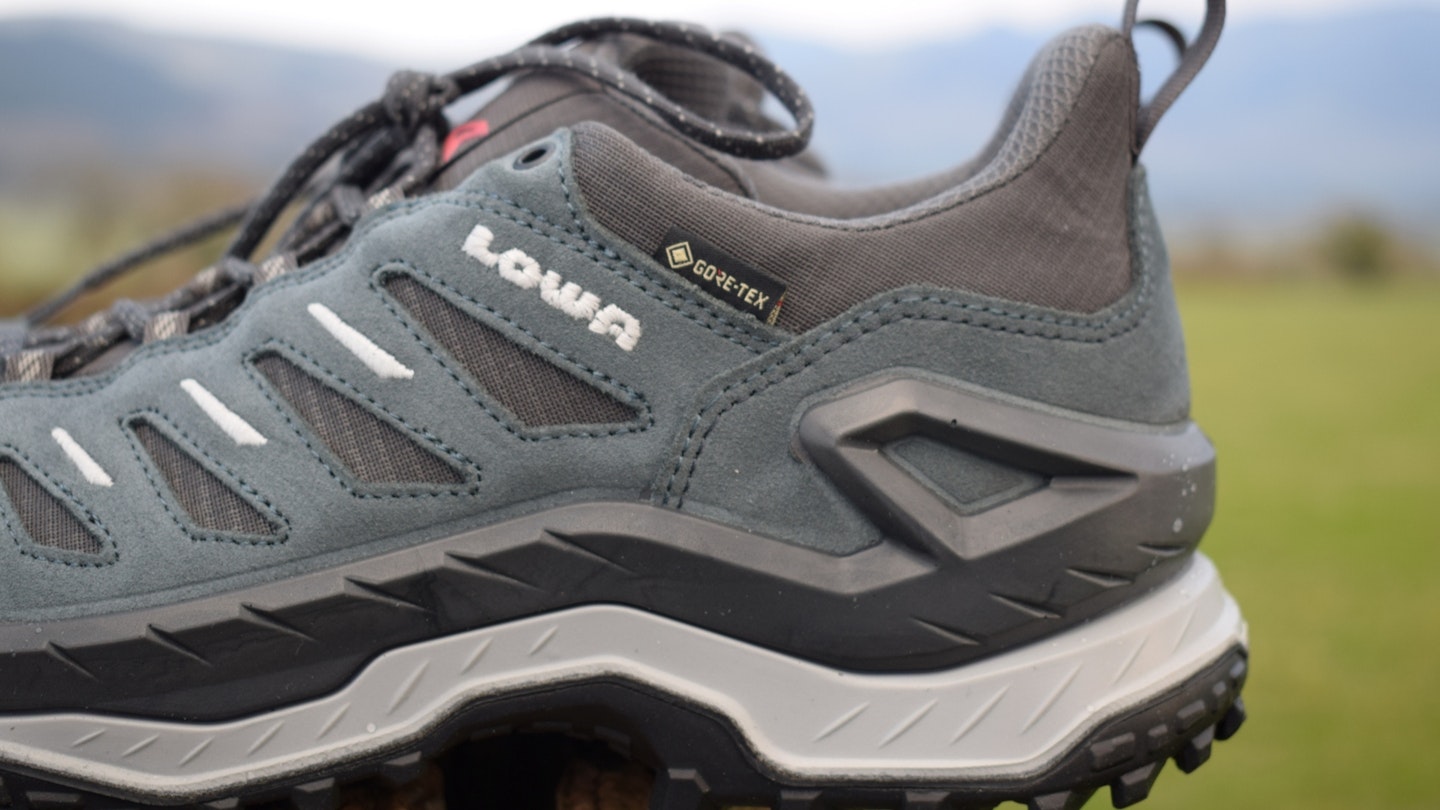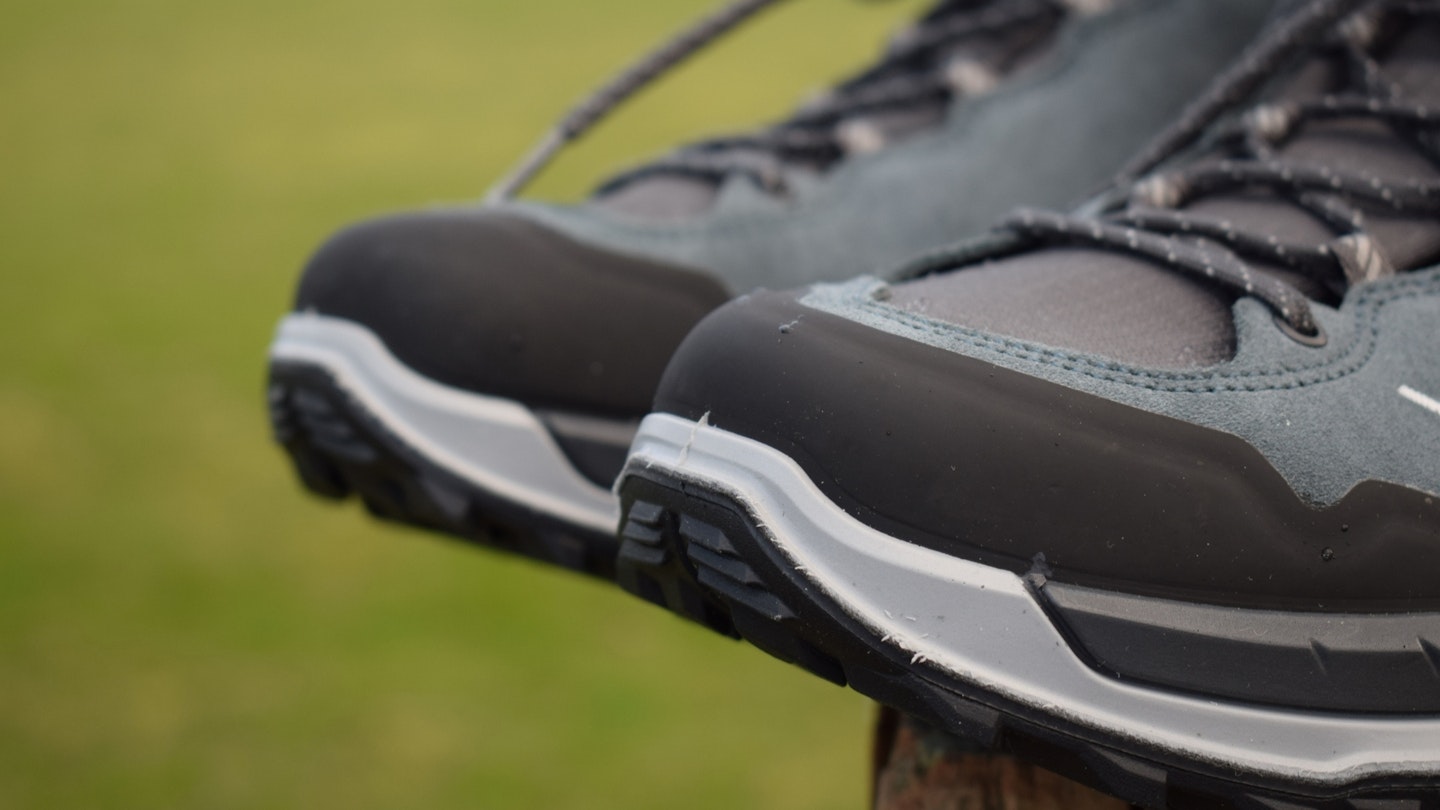One of Lowa’s mottos is “tradition and innovation”. I’m going to stick my head out and assume the ‘Innovo’ in the name of the Innovo GTX Lo is a nod towards innovation, yet for me these artfully crafted hiking shoes have more of a traditional aesthetic and style. They look and feel every inch the classic mountain shoe.
Featuring a breathable and waterproof Gore-Tex lining, a luggy, chunky and rigid proprietary outsole, an attractive suede upper, a reinforced toebox and a wonderfully cushioned and supportive midsole – the Innovo ticks all the boxes you’d expect from a burly walking shoe.
Particularly notable is the 'Monowrap' support frame, which cradles the foot, providing exceptional stability on technical terrain. Cushioning comes courtesy of a double injected PU foam that maintains its shape over many years of use.
It’s relatively heavy for a hiking shoe – I weighed it at 490g per shoe (UK men’s 8) – so isn’t an ideal option for fast and light adventurers. It's not as tailored towards scrambling as approach shoes – though admittedly it holds its own on steep rock.
However, for comfort and stability on long day hikes, hut-to-hut treks or for relatively lightweight backpacking, the Innovo has you covered.
Find the women's version here.
Pros
- Very comfortable
- High levels of support
- Mud-gripping outsole
Cons
- Relatively heavy for a shoe
- Pricier than most
- Not the most versatile
| RRP: | £170/$210 |
| Men’s Sizes: | UK 7-13 |
| Women’s Sizes: | UK 3.5-8 |
| Weight: | 490g/17oz per shoe (men’s UK 8) |
Upper and waterproofing
A blend of ripstop fabric and suede is present in the upper, striking a balance between softness and durability. Suede is a type of leather that’s taken from the lower layers of the hide.
It’s got more elasticity than leathers taken from the upper layers, such as nubuck. The result is a material that feels less restrictive. However, it’s not quite as hard-wearing or as resistant to scrapes with rock as nubuck, which is also often used in hiking footwear.
Mesh panels along the outside foot and a large area at the toes provide channels for moisture to escape more readily, thus making the shoe more breathable. As you’d expect of a mountain hiking shoe, the toe box is nicely reinforced. This enabled me to be aggressive with my foot placements on rocky trails.

A Gore-Tex lining beneath all of this keeps the drink at bay, so long as you don’t decide to leap, Vicar of Dibley style, into any substantial puddles. Of course, boggy terrain is the bane of low-cut hiking shoes, so you’d want to pair these with gaiters if you plan to traverse drenched moorland or cross soggy cols.
The lacing system is fairly standard, though there’s an extra pair of punched eyelets at the top of the shoe, which allowed me to customise the fit by bringing things in tighter around the ankle if necessary.
Midsole
Lowa’s proprietary technologies and materials are at play right across the shoe and the midsole is no exception. A cushioned double injection foam, made of Lowa’s DynaPU+, provides cushioning and propulsion.
This polyurethane material rebounds to its original shape even after prolonged use, maintaining the shoe’s bounce, supposedly for "many 100s of miles". Time will tell how true this statement turns out to be, but it’s a case of so far so good.

Meanwhile, lateral support is achieved thanks to the Monowrap stability frame, also made of PU, which effectively cradles the foot. This all results in a ride that feels secure and comfortable even on sharp, gnarly terrain.
The midsole combines with the semi-rigid outsole to provide flexibility towards the front of the foot, working with the natural roll of a hiker’s stride.
Outsole
Lowa describes the outsole as chunky on its website and I concur that it has plenty of heft. Manipulate the shoe in your hands and it becomes clear that this is where the bulk of its 490g is contained.
There are many more individual lugs here than on most shoes – 66 by my count! This includes the effective braking system at the back of the shoe, designed to provide traction on loose ground in descent.
While there’s no approach shoe style climbing zones, the overall surface area of the many flat-topped, trapezium-shaped lugs mean that the shoe holds capably on flat slabs.

Lowa has put its Terra Trac rubber to use in the sole. This proprietary compound is specifically designed for the kind of rough terrain the Innovos are intended for, dishing out solid traction on rock, while the arrays of lugs do their thing on the sloshy stuff.
It should be noted that the Innovo is not resole-able, which seems a shame considering many brands are bending over backwards – and so they should be – to build circularity into their outdoor gear.
Price and performance
The Innovo GTX Lo isn’t the cheapest hiking shoe out there. In fact, for £170, you’re probably within your rights to expect a full-on hiking boot, rather than a low cut shoe.
For £20 more, you can get hold of the Innovo GTX Mid version, which offers additional ankle support and more protection against water ingress, albeit with a weight penalty.
The fit is generous and very comfortable. Compared to other shoes in our recent batch of hiking shoes on test, my foot felt embraced and welcomed by the boot. Where the Scarpa Rapid XT GTXs felt like functional tools to be put to use, the Innovos feel like homes for my feet to enjoy.
The toebox is spacious and the shoes never feel particularly narrow. On the flipside, I don’t get the sense of precision as with the Scarpas or with the La Sportiva TX5 Low GTXs, but the Innovos aren’t primarily designed with rocky scrambles in mind.

Having said that, the Innovo is well suited to low grade scrambling terrain, more so than lighter hiking shoes. The sole is relatively rigid and the stability provided by the midsole helps.
They’re a little wider than some approach shoes, so some narrow cracks are off limits but, admittedly, I’m clutching at straws a little here – go ahead and get your scramble on!
It’s as a good, old-fashioned hiking shoe that the Innovos really excel. I had very few qualms with them when put to this intended use. Traction is a strength – the shoe’s many lugs bite hungrily into the muddy stuff, while they also hold firm on scree and the like.
I barely noticed their weight, too. It seems that the qualities that Lowa has prioritised around comfort, support and protection, rather than keeping the gram count down, have paid dividends. This is a shoe I’d quite happily walk around all day in.
Verdict
The Lowa Innovo GTX Lo are traditional looking hiking shoes, which deliver exceptional comfort and capability for all manner of hillwalking adventures. The midsole provides solid support and stability, while the outsole performs well on our often soggy mountain terrain.
A relatively supple but hard-wearing upper blends ripstop fabric with suede, with additional protection for the toes.
They’re heavier than most, so aren’t for fast hikers or those who enjoy to mix in the occasional run while out in the fells. Nevertheless, for a standard hiking shoe for those who explore at a sensible pace, look no further.
For some expert tips on how to choose hiking shoes, check out our buying guide.
Shop this product
About the author

James Forrest writes regular features and route guides for Trail and LFTO, and has been one of our main gear testers for the last few years. James is based on the edge of the Lake District so when he isn’t off on his latest crazy adventure or challenge, he’s walking in his local fells.




